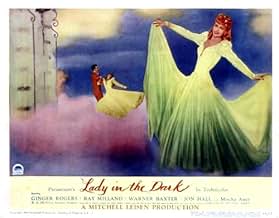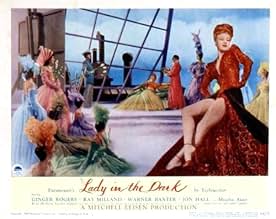IMDb RATING
5.9/10
609
YOUR RATING
Liza Elliott, "Allure" magazines editor-in-chief, suffers from headaches and continuous daydreams and undergoes psychoanalysis to determine why.Liza Elliott, "Allure" magazines editor-in-chief, suffers from headaches and continuous daydreams and undergoes psychoanalysis to determine why.Liza Elliott, "Allure" magazines editor-in-chief, suffers from headaches and continuous daydreams and undergoes psychoanalysis to determine why.
- Nominated for 3 Oscars
- 1 win & 3 nominations total
Featured reviews
I won't criticize much because I really like everything that Ginger Rogers does, yet somehow I get the feeling about this film, "there should have been more." At least I think more could have been done with the story.
Also, it brings to mind her later film, "It had to be You" which is a similar, comedic journey into the subconscious layers of the mind, obviously a popular topic of the day.
Ray Milland is in fine form here and I consider it one of his best roles.
The scenes are beautifully presented, very stagey at times with actors seemingly going through the motions, but the artistry of the settings and gowns is impeccable. All in all it's meant as light entertainment and ought to be viewed in that manner. Wish the video was available too.
Also, it brings to mind her later film, "It had to be You" which is a similar, comedic journey into the subconscious layers of the mind, obviously a popular topic of the day.
Ray Milland is in fine form here and I consider it one of his best roles.
The scenes are beautifully presented, very stagey at times with actors seemingly going through the motions, but the artistry of the settings and gowns is impeccable. All in all it's meant as light entertainment and ought to be viewed in that manner. Wish the video was available too.
Liza (Ginger Rogers) is the editor of a magazine who can no longer make decisions. She suffers headaches because she is highly strung about work and she has a love life that she is not comfortable with. Through psychoanalysis with Dr Brooks (Barry Sullivan), she unravels her troubles by recounting 3 dream sequences. Can she regain her decisiveness?
This film is a bit girly in that it concerns one woman's journey to discover lost memories and understand her behaviours. It has great colour, good costumes and it's well acted with a spattering of humour throughout. The bulk of the film comes in the form of dream sequences which are musical, colourful and surreal. The 2nd sequence has a pointless dance scene which drags on a bit but overall the dreams are entertaining. The rest of the film follows the romances that Liza has alongside her role as a tough "boss lady". The film is fun and has a happy ending.
This film is a bit girly in that it concerns one woman's journey to discover lost memories and understand her behaviours. It has great colour, good costumes and it's well acted with a spattering of humour throughout. The bulk of the film comes in the form of dream sequences which are musical, colourful and surreal. The 2nd sequence has a pointless dance scene which drags on a bit but overall the dreams are entertaining. The rest of the film follows the romances that Liza has alongside her role as a tough "boss lady". The film is fun and has a happy ending.
I found this to be moderately enjoyable and much smoother than I was expecting, after reading of all the problems in making it and the cutting of musical numbers from the original score. Would love to see it as was originally intended (in a restored DVD version).
The psychoanalysis as it unfolds is interesting and makes sense, except to the point of the woman needing to be dominated by the man. I don't know if this was dictated by the culture of the time, but all that was really needed was for Liza to know she needed to give time to gaining fulfillment in a relationship (without the aspect of dominance) and not be so driven work wise (her substitute), and it would have come out without the nasty taste it leaves now (in regards to this aspect of the film).
Director Mitchell Leisen dealt with this sort of theme also (without the psychoanalysis) in Take a Letter Darling which was funnier and sharper, and without the need for the man to have to dominate the woman.
Some of the visual imagery in the dream sequences is a lot of fun and apparently a lot of care was put into their production.
As well the movie seems like it is a 50s product but that could just be the colour.
The psychoanalysis as it unfolds is interesting and makes sense, except to the point of the woman needing to be dominated by the man. I don't know if this was dictated by the culture of the time, but all that was really needed was for Liza to know she needed to give time to gaining fulfillment in a relationship (without the aspect of dominance) and not be so driven work wise (her substitute), and it would have come out without the nasty taste it leaves now (in regards to this aspect of the film).
Director Mitchell Leisen dealt with this sort of theme also (without the psychoanalysis) in Take a Letter Darling which was funnier and sharper, and without the need for the man to have to dominate the woman.
Some of the visual imagery in the dream sequences is a lot of fun and apparently a lot of care was put into their production.
As well the movie seems like it is a 50s product but that could just be the colour.
A Technicolor spectacular, with costumes and wonderful sets to match, but the story isn't much, mostly what you might expect to read in Popular Psychoanalysis magazine.
Best are the dream and reverie sequences, especially the trial in the circus ring. These are where the singing and dancing is, but there is not much and what little there is is not very exciting.
Best are the dream and reverie sequences, especially the trial in the circus ring. These are where the singing and dancing is, but there is not much and what little there is is not very exciting.
I like this movie. It is confusing and difficult, but you can't help but like it. Ginger Rogers plays a fashion magazine editor...and she finds herself having headaches and feeling dissatisfied. This makes no sense, as she has an exceptional job (especially for 1940) three suitors, and conscious and unconscious lives that are fabulously costumed. She goes to her doctor who recommends a psychiatrist...a drastic move for the time...which she promptly declines...but then does finally go to. Ginger undergoes a great deal of stress in this film,and keeping a bottle of aspirin at hand might be wise. As she makes progress with her shrink...her dream sequences become more and more lavish. The film is beautifully costumed...even clothes left lying on a chair...are fabulous. And there are HATS. HATS. Hats... mousey through military...lots of hats...and FURS...Ginger has one dress with a floor length mink skirt...lined with gold and scarlet sequins, two or three fur coats, a muff, and several other dresses trimmed with fur. Pull the shades and make certain that no one from PETA is around when you run this film. The dream sequences are the real meat of this...they are very beautiful and very surreal. In the end, of course, Ginger selects one of the men (no, not the married one) and seems to be on the road to recovery. You get the feeling that a lot got left out...and I don't know what (yet). I know Danny Kaye was 'discovered' in the Broadway show...and that he had special material. Danny was under contract to Sam Goldwyn by the time this was made...so neither he nor any of his special material made the transition into this film. This film is a visual knock out...and a restored print should be made and hi-def DVD's struck...so we can watch this from time to time. It cannot help but remain dated and politically incorrect....that is the legacy of its 1940 dateline.. but it will certainly always be stunning to look at.
Did you know
- TriviaThis was one of the first films to use the word "sex." Ray Milland says, "Rage is a pretty good substitute for sex, isn't it?"
- Quotes
Russell Paxton: "This is the end! The absolute end!"
- Crazy creditsAt the start of the film the Paramount logo is set at night, in the dark.
At the end of the film the Paramount logo is seen at dawn, come into the light.
- ConnectionsReferenced in Book Revue (1946)
- SoundtracksMain Title
Music by James Jimmy Van Heusen and Lyrics by Johnny Burke
Performed by the Paramount Studio Orchestra and Chorus
- How long is Lady in the Dark?Powered by Alexa
Details
- Runtime
- 1h 40m(100 min)
- Aspect ratio
- 1.37 : 1
Contribute to this page
Suggest an edit or add missing content



































